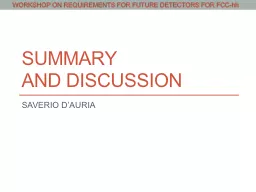

AND DISCUSSION SAVERIO DAURIA WORKSHOP ON REQUIREMENTS FOR FUTURE DETECTORS FOR FCC hh SUMMARY E xpertise from various experiments and from people with different background We tried to factorize what is not ID: 279126
Download Presentation The PPT/PDF document "SUMMARY" is the property of its rightful owner. Permission is granted to download and print the materials on this web site for personal, non-commercial use only, and to display it on your personal computer provided you do not modify the materials and that you retain all copyright notices contained in the materials. By downloading content from our website, you accept the terms of this agreement.
Slide1
SUMMARY AND DISCUSSION
SAVERIO D’AURIA
WORKSHOP ON REQUIREMENTS FOR FUTURE DETECTORS FOR FCC-
hh
Slide2
SUMMARY
Expertise from various experiments and from people with different background We tried to factorize what is not
factorisable
.
Time and space resolution are closely relatedRadiation resistance depends on technology details Stimulate discussion and look from different points of viewSome aspects are missing: more study groups to come, we focused on some of the main issues.Preparation for the FCC-week in Washington DC http://indico.cern.ch/event/340703/overview
WORKSHOP ON REQUIREMENTS FOR FUTURE DETECTORS FOR FCC-hh
2
S. D'Auria - CERN FCC-
hh
detector workshop Slide3
SUMMARY
Very difficult to make forecasts to 15 yeas from today.Identify what is physically
not impossible
Technology markets are driven by other factors
More innovative (but feasible) ideas are more likely to drive the market.R&D for FCC-hh is a natural continuation of R&D for HL-LHC. Synergy rather than competition for resources.Some aspects can be peculiar to 5 ns bunch crossing.
WORKSHOP ON REQUIREMENTS FOR FUTURE DETECTORS FOR FCC-hh
3S. D'Auria - CERN FCC-
hh
detector workshop Slide4
CONCLUSIONS
Detectors for inner tracking are considered to be feasible for 20 ab-1
, 5 ns, <
m
> = 190 pile up collisions.Sub-ns time resolution, sub-micron space resolution and radiation tolerance to ~2 – 20 x 1016 appear as natural evolution of present technologiesMinimal FCC-hh target specifications are almost achieved in dedicated detectors.However, not one single technology reaches all design specs at the same time. Trade-offs to be considered, at a certain (later) stage.
The main issue is coverage at small radius. Radiation hardness and granularity are a limit here. R&D as improvement over present technologies.
WORKSHOP ON REQUIREMENTS FOR FUTURE DETECTORS FOR FCC-hh
4
S. D'Auria - CERN FCC-
hh
detector workshop Slide5
CONCLUSIONS
Several sensor technologies are promising.Microstrips will be replaced by pixels everywhere ?
Big technology step: integrated electronics: already in use, ubiquitous in the future
?
Cooling is feasible, several evaporative technologies, has to scale up in size even if lower power per module is achieved to < 1W/cm2. Application for nano-materials developmentAlignment: state of the art at micro-meter level. Further R&D may be required to go to sub-mm. Important to develop design detail with alignment
sw experts and mech. engineers. WORKSHOP ON REQUIREMENTS FOR FUTURE DETECTORS FOR FCC-
hh
5
S. D'Auria - CERN FCC-
hh
detector workshop Slide6
DISCUSSION
Evolution of existing technology vs. radically different solution: for long term project, but generally considered risky.
All non-silicon detector developments are still a niche
after LHC R&D
: Diamond, GaAs, SiC, GaN, ….
WORKSHOP ON REQUIREMENTS FOR FUTURE DETECTORS FOR FCC-hh
6S. D'Auria - CERN FCC-hh
detector workshop Slide7
DISCUSSION
The ideal solid state detector:single-crystal Diamond (for highest carrier speed)
w
ith integrated electronics
10 mm x 10 mm cell, A4 paper format.Self-cooling (high heat transmission)Radiation resistant to 1017 1-MeV n/cm2With wireless/
copperless readoutWith wireless/copperless powerAt 1 $/cm2
WORKSHOP ON REQUIREMENTS FOR FUTURE DETECTORS FOR FCC-hh
7
S. D'Auria - CERN FCC-
hh
detector workshop Slide8
DISCUSSION
The ideal solid state detector.
Can we dream of such an evolution ?
WORKSHOP ON REQUIREMENTS FOR FUTURE DETECTORS FOR FCC-
hh
8S. D'Auria - CERN FCC-hh detector workshop Slide9
DISCUSSION
Where do we go from here
RD50 natural continuation as rad-hardness
Working groups based on
TechnologyDetector location (central, forward, very forward…) ?“Exotic” solutions ? Common issues: cooling, mechanical support, data read-out, power distribution.
WORKSHOP ON REQUIREMENTS FOR FUTURE DETECTORS FOR FCC-hh
9
S. D'Auria - CERN FCC-
hh
detector workshop Slide10
SUGGESTION
Some semiconductors (
non silicon) used to be called the “material of the future”..
We obviously need to change name to FCC …
asap WORKSHOP ON REQUIREMENTS FOR FUTURE DETECTORS FOR FCC-
hh 10
S. D'Auria - CERN FCC-hh detector workshop